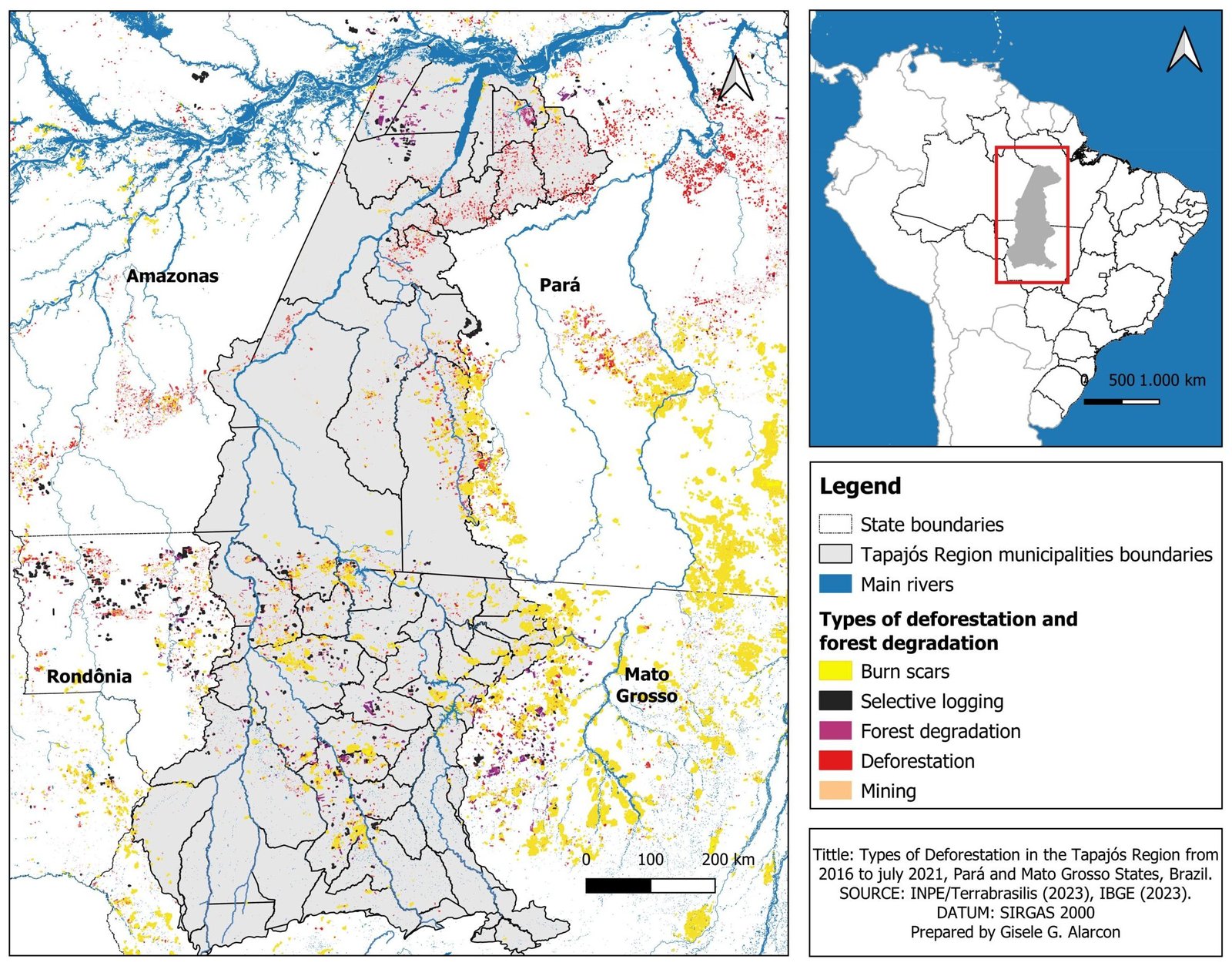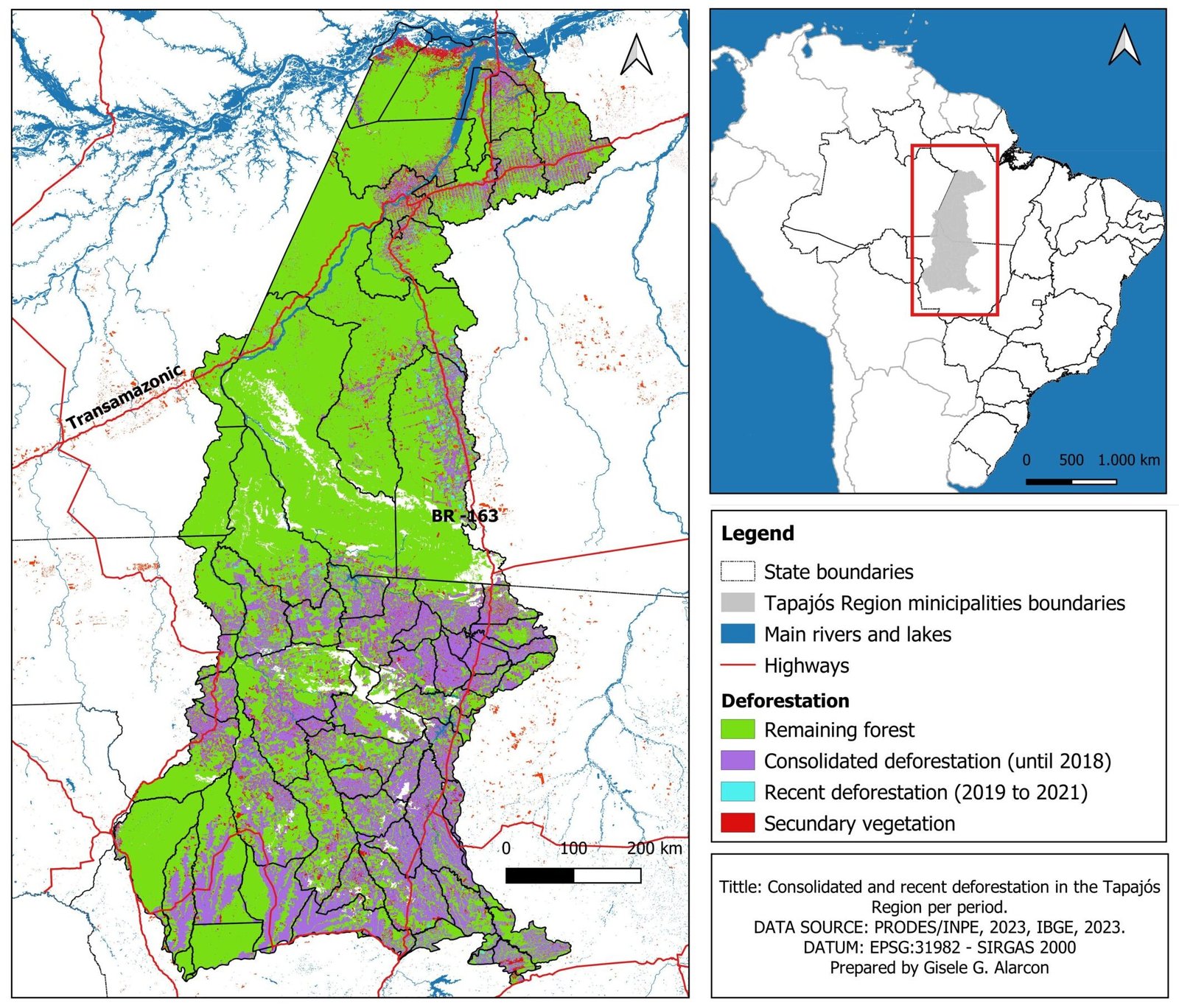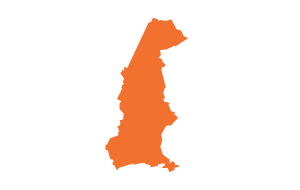TERRITORIAL IMPACT OF GLOBAL EXTRACTION
Biodiversity Loss and Climate Change
In the Tapajós Region biodiversity loss is directly related to deforestation and forest degradation, as well as to sociobiodiversity loss by indigenous people and traditional communities managing natural resources for centuries. Pasture and soy plantations, gold mining and the expansion of infrastructure associated with agromineral commodities are the main pressure factors associated with deforestation. Fire and selective logging are normally the first stage of deforestation and represent the main factors causing forest degradation in the Tapajós Region.
Historically, the states of Pará and Mato Grosso have interchangeably led deforestation rates in the Legal Brazilian Amazon since 1988. The Legal Amazon is an administrative planning region in Brazil that stands for states and municipalities comprising both the Cerrado (Brazilian Savannah) and the Amazon biomes, particularly in its transition zones, where commodities frontiers expansion persists and has significantly increased since mid 1990s. Brazil, and especially the Legal Amazon, was marked by a significant drop in deforestation between the years 2003 and 2012, when deforestation dropped from around 25,000 km² to just over 4,000 km². However, in the Bolsonaro government, deforestation indexes rose again. Between 2012, when deforestation reached the lowest rate since 2000, and 2022, deforestation in the Legal Amazon rose 153%.
The Tapajós region followed high levels of deforestation following the pattern observed in other states of the Legal Amazon. According to the Brazilian Institute of Spatial Research (INPE), between 2016 and 2020, deforestation has increased by 231% in the region. Such level encompasses dimensions of deforested land that has varied from approximately 46,000 hectares to 152,000 hectares in the four year range observed. Weak environmental governance and incentives to deforestation due to fraught monitoring along this period led to forest loss, particularly in non-designated public lands. It is important to highlight that levels of deforestation also increased in rural private properties, conservation units, including those designated to the sustainable use of traditional communities, and Indigenous Territories. In the latter case, deforestation was a consequence of invasions by grileiros (land grabbers). This historical social (and illegal) group very present in Brazilian agrarian history is usually incentivized by larger structures of land speculation and concentration connected to finance, infrastructures as well as international commodity trade and prices.
Mining and fire scars had been the modalities of land conversion attesting for most of deforestation increases between 2016 and 2020. In the case of gold mining, an activity that represents a large portion of the Tapajós region economy, particularly in the Mid and Upper Tapajós River cities, most of it is carried on an illegal basis. This activity increased by 360% between 2016 and 2020, while fire scars increased by 390%, reaching 262,000 hectares in 2020.

Types of deforestation accumulated for the period 2016-2020 in the Tapajós Region, Brazil.
In the last decade, Protected Areas (PA) also registered rising indexes of deforestation. The accumulated deforestation in the PA of the Tapajós Region between 2008 and 2022 resulted in the loss of about 266,000 hectares of forest. Among the 10 PAs with the highest rates of deforestation in the Legal Amazon, two are located in the Tapajós Region, the Tapajós Environmental Protection Area and the National Forest (FLONA) of Jamanxim. The FLONA of Jamanxim accumulated 42% of the total deforestation in PA in the Tapajós Region in this period.

Consolidated and recent deforestation per period (2008-2018 and 2019-2021) in the Tapajós Region, Brazil.
The state of Pará has sought to place itself as a protagonist in actions to reduce greenhouse gas (GHG) emissions, especially linked to deforestation in the Brazilian Amazon. In 2020, the state enacted the Plan Amazônia Agora which aims to achieve the Sustainable Development Goals (SDGs) of the United Nations (UN) Agenda 2030; to implement the instruments for achieving the “Reduction of Emissions from Deforestation, Forest Degradation (REDD+) mechanism; to implement the National Determined Contributions (NDCs); and encourage activities that promote the prevention and mitigation of Greenhouse Gases (GHG) emissions. As part of this strategy, the state is developing the Project Descarboniza Pará, which seeks to achieve climate neutrality in the area of “land use and forests” before 2036, and is funded by the IDB (Inter-American Development Bank). Another initiative is the state Bioeconomy Plan (PlanBio), launched in 2022, whose objectives include the reduction of GHG emissions and the promotion of sociobiodiversity value chains in Pará.
Paradoxically, Pará occupies the ranking of the Amazonian states with the highest deforestation rates since 2006 and ranked first in GHG emissions in Brazil in 2021. Since 2017, emissions in the state have increased by 70%. In 2021, 85% of emissions were associated with changes in land use and forests, while in Brazil this index was 49% (SEEG, 2023).
There are several criticisms of the plans and policies aiming to adapt and mitigate climate change in the state. Criticisms include the lack of effective participation of indigenous peoples and traditional communities, the centralization of decision-making in public institutions, the absence of clear targets for reducing emissions and of sanctions in case of non-compliance with the measures proposed by the sectors involved.
In the Tapajós Region, the scenario of the investments and policies towards agromineral commodities production/extraction and infrastructure for transportation are on the opposite side of the climate and biodiversity policies announced by the state. New infrastructure projects as the Tapajos waterway, Ferrogrão railroad, new port terminals in Itaituba and in the Lake Maicá represent the consolidation of region as a hub of commodities exportation, which, in turn, encourages the conversion of forests into production and extraction areas, directly affecting emissions and biodiversity.
Environmental Justice
The continuity and process of expansion of gold, soy and cattle production and the implementation of the necessary infrastructure for their storage, transport and exportation is causing violation of the rights of indigenous peoples and traditional communities in the Tapajós Region. The Cargill Port, for example, was installed in Santarém without an appropriate environmental impact assessment, as required by law. The port lies over the main leisure place of Santarém. In Itaituba, the port terminals of Miritituba are under a Munduruku archaeological site, whose pieces were neither removed nor relocated and the claims of the Munduruku people were never heard. The port terminal planned by EMBRAPS on the Lake Maicá, in Santarém, will cause large alterations in the local socio-ecological dynamics, affecting subsistence fishing activity and income generation for approximately 1,500 riverine and quilombola families living on the shores of the Lake. Besides, Maicá houses the oldest known archaeological site in Santarém, which is 8,000 years old, in addition to many other recent sites (between 500 and 2,000 years old) that are not yet mapped. In the same way as in the case of Cargill, the installation of the EMBRAPS port at the Maicá violates the Convention 169 of the International Labor Organization (ILO), as it does not carry out the determinations of the communities consultation protocols, nor does it respect its decisions.
Other types of violations include the expulsion of small-holder farmers settled by the Agrarian Reform from their lands and enticement by farmers, usually coming from the south and center-west of Brazil, stimulated by the offer of cheap land suitable for the soy and cattle production. The arrival of farmers in agrarian reform settlements result in death threats to leaders who oppose the leasing or sale of rural lots. There are situations where these leaders are put into the Protection Program for Victims and Threatened Witnesses of the Secretary of State for Justice and Human Rights, developed in partnership with the Federal Government. In Pará there are 53 people linked to Human Rights who are under this Program and many of them are in the program due to agrarian conflicts. This type of dispute over land also occurs in indigenous and in quilombola territories. The practice of land grabbing in this region has caused, in addition to death threats, assassinations.
According to the Pastoral Land Commission in 2022, 22 death threats were registered due to rural conflicts in Pará, 7 of them were in the Tapajós Region. For the whole state there was registered 175 rural conflicts in 2022, involving more than 3,000 families.





